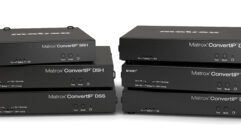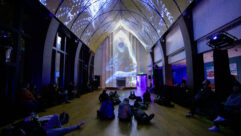
Modern Government AV, Part 2
Apr 2, 2013 3:55 PM,
With Bennett Liles
Listen to the Podcasts

Editor’s note: For your convenience, this transcription of the podcast includes timestamps. If you are listening to the podcast and reading its accompanying transcription, you can use the timestamps to jump to any part of the audio podcast by simply dragging the slider on the podcast to the time indicated in the transcription.
A complete courthouse renovation included new sound systems and acoustic modifications. RG Sound and Communications in Celina, Ohio, was brought in for the job and Shawn Snider is back to wrap up his account of how it all happened when he brought new sound technology to an 19th century building.
SVC: Shawn Snider from RG Sound and Communications, thanks for being back on the SVC Podcast for part two on the Auglaize County Courthouse renovation project. A total revamp on the inside of the building, but they didn’t want to spoil the classical look on the outside of it. Three courtrooms to outfit and we talked in part one about the Ashly Pema amplifiers and processors but we didn’t talk about the ceiling speakers. What did you pick out for those?
Yeah, we actually went with surface-mount speakers, the Community DS-8s. I have the specs right in front of me and they’re just an 8Ω, 8in. and a 1.25in., so they’re about probably 1ft. tall and maybe 8in. deep—very compact, sound wonderful. In this case we got them in white to match. That was one of the things they were concerned about was aesthetics. And they all mount on a ball sort of hinge mount, so they can be directed any direction, which made it very versatile for hanging. [Timestamp: 1:48]
Yeah, I was going to ask were there any architectural or electrical challenges in this. The thing was a complete re-do, but that’s an old building. How much was the electrical system redone?
You know, not too much. I think they left a lot of that intact. One of the things they did for us was run the wire, and I don’t want to say it was unfortunate, nor was it fortunate. We were very limited to speaker placement and exactly where we were going to aim the sound. However, we also didn’t have to run the wire, so it was sort of a two-fold, you know. [Timestamp: 2:20]
Well, it was a little bit of a trade-off.
Right. Exactly. It was a good and a bad scenario. Obviously they were concerned about the architectural appearance. They had a brand new place, but still inside of a very 19th-century-looking building. And that is one of the reasons we went with the Community speakers, because they’re very timeless. You know, they’re very smooth and sleek and they blend right in. [Timestamp: 2:39]
Now we talked before about these really nifty monitors for the people in the jury box. Who controls when the monitors come up? I guess the judge handles that?
Yeah, I’m assuming it’s just a button that he pushes and up they come.
Right, so they can see stuff and then not see stuff.
That’s correct. [Timestamp: 2:54]
And I would think that it could make an important difference on whether there’s a mistrial or the outcome of an appeal and so forth about which evidence the jury was allowed to see.
Yep, absolutely. I know that they had big plans for using that. You know, it’s one of the things that all of the prosecutors said, “Boy, I wish we had that.” And now they do, so I’m sure it will be put to good use. [Timestamp: 3:15]
And you also put in an NTI AV matrix switcher?
We did, yep. And we were really excited about this product. It was something that we had never really used. We’d played around with the idea and this was a great application for it, so we went for it. NTI was great throughout the whole thing; plenty of support. How the system essentially works is it’s a Cat-5 matrix and we used a series of Cat-5 extenders to reach out to the monitors and in from the sources. So the system is set up so that, for example, a prosecutor can come in and sit down at the table and all he has to do is plug his laptop in sound as well. So he’s got a VGA out and an audio out. The matrix will automatically detect that and it automatically scales and it finds that stuff. So the judge says, “Okay, the prosecutor wants to show a video.” He pulls up his web-based interface, because everything again is on their network, and he can just select a preset or he can select exactly what table and what monitors he wants that video and audio to go to, and it’s magic, you know? There it is. And it can’t be much simpler than that with auto-scaling and with things like that it’s in a one-U box, so it makes for a very compact package. [Timestamp: 4:35]
Modern Government AV, Part 2
Apr 2, 2013 3:55 PM,
With Bennett Liles
I would think that among the attorneys on these trials they probably run into every degree of expertise from total technophobes all the way up to some very tech-savvy people. So you have to have a system that will accommodate any degree of technical expertise.
The great thing about the NTI is that would patch audio with a video as well, so you have that audio that automatically patches to the Ashly Pema, which is automatically going to adjust the gain. So no matter how they have their laptop set up, that Ashly’s going to pick it up and adjust it for an optimal performance. [Timestamp: 5:09]
And it’s networked. It has to be in a secure location inside the courthouse so what can you do with it over the network? Can they go back to you and say, “Make and adjustment here or there or reconfigure it?”
As of right now they do not, but they could. If they would want to port forward all that stuff to us, we could definitely hop online and adjust all of that stuff. However, I think the concern there was we would have, then, access to the courthouse network, you know, from our personal computers, and to access anything on their network which might not be so secure for them. But we’re more than happy to come do a service call. Sometimes it’s better to just stay out of it. [Timestamp: 5:47]
Yeah, I would think that not only the network, but if they’re using any sort of wireless systems in there it could be a security issue.
Right, absolutely.
And you put in the ceiling speakers. How were the acoustics in those courtrooms? I know they wanted to maintain some degree of the original architecture. Was there any sort of acoustic treatment that had to be done?
Yes. Yes, extensive acoustic treatment, in fact, in the upper two courtrooms especially. They’re quite a bit larger than the downstairs courtroom and they all have tin ceilings, which is sort of a pseudo nightmare for us sound guys. Not only do they reflect audio, they reverberate, as well, or resonate, I should say. So it was a sort of a square, tin roof or a tiled ceiling, I should say. They went ahead and had squares cut specifically for each one of the tiles in the tin and then secured them fast. So the entire ceiling is essentially covered with acoustic, absorptive tiles. Same with the walls. Large tiles on the walls that have really helped to make those rooms sound great. Now the downstairs room is much smaller, much more sort of a classroom feel in there, so they opted just for some thick velvet curtains to cover some of those hard walls. I believe it’s just probably double brick, or stone in some cases, that’s been covered with plaster. So very hard, not a lot of absorption there, and they went with just some curtains and it seems to be working pretty well for them. [Timestamp: 7:13]
Is the system all centrally located so that all the processing is in one rack for all the rooms or does each room have its own separate processing and amp location?
Yeah, no, that was actually one of the challenges of the project. They wanted the U system to be fully independent, you know, that way if one went down, none of the other ones would be affected. So they did want all of the processing held in a sort of a broom closet, if you will, not near big enough to keep a rack in. So everything had to be housed on sort of a commercial shelving unit that you might get at a local hardware store. That’s again why we thought smaller is better if we’re going to be limited to a closet like this without a rack. Let’s go as small as we can, and it’s worked out great. [Timestamp: 7:57]
You would have to have something that runs pretty cool, too. I would think that there might be ventilation problems since that place wasn’t designed for rack-mounted AV gear.
Exactly. Exactly.
How was the system tested once you got it all hooked up? How did all that go? Did a lot of people show up to get trained for it?
They very well might have. Again, I sort of worked with Cameron, who was the technology director there, and then it fell on him to showcase the system at an open house, which I hear that he did some really amazing things there. He networked all three together so he could stream music from an off-location source and kind of put it in all three rooms at once, which is really innovative and creative of him to do. But I worked with Cameron, sort of taught him the basics of how it worked and things to watch out for and how to correct the system when it started to go wrong, and then he was responsible for training the attorneys and the judges. Again, the system was supposed to be so simple that there really didn’t need to be any training, and that certainly was their goal. As far as tuning the system, pretty straightforward and standard. We started with just some pink noise and that got our delays in line. The speakers are not together. They’re probably at the, I don’t know, 10ft. or 20ft. delay so we had to make sure delays were okay. Again we’re using sort of an automatic EQ and an automatic gain system, so there wasn’t a whole lot of work there. We just had to monitor it to make sure that it was, indeed, working correctly. When they integrated the black box and all the microphones, it was just a matter of working together with those two programs and those two sets of software to find a nice gain structure that provided the amplifier plenty of source to work with while not overdriving the black box software. [Timestamp: 9:36]
Well, that system should be adaptable enough to serve their needs for some time to come. So what’s coming up for RG Sound and Communications? Got some more projects coming up?
Yeah. Right now we have a few churches in the works. We’re trying to offer sort of a new package, you know, especially for churches and especially in a time like now where the economy is rough. You know, we see a lot of churches that are struggling and a lot of churches that are looking for a bit of a facelift in the AV department. And I kind of assigned myself to the task of coming up with a very basic system, but robust, that would be at the $10,000 price point. And that’s just something you don’t see a lot of professional vendors doing these days. And we took on the challenge, you know? We wanted to offer them full-out digital boards and we wanted to offer them plenty of power but keep the cost as low as we could. So we have a couple of pilot churches that we’re trying some different things with, and so far it’s worked out really well. [Timestamp: 10:35]
Well, the church AV business is definitely holding up and that’s a pretty good place to be right now. And the Auglaize County Courthouse looks like it’s in good shape now. Thanks for coming by to tell us about this one and good luck with the stuff coming up. Shawn Snider and RG Sound and Communications.
All right. Hey, thanks.










